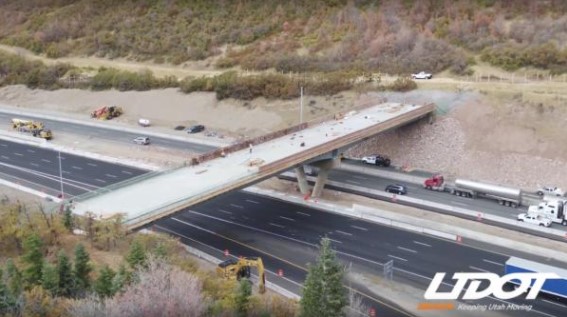Parleys Canyon Wildlife Bridge
Contents |
[edit] Introduction
A green bridge (also known as a wildlife crossing) allows the safe passage of wildlife over infrastructure such as railway lines and roads.
In December 2018, the Utah Department of Transportation (UDOT) announced plans for one of the largest wildlife overpasses in the United States. The structure was completed in 2019. It is 110 metres long, 15 metres wide and crosses six lanes of Interstate 80 (I-80). It is the second wildlife overpass in the state of Utah.
[edit] History
Funding for the Parley’s Canyon crossing came from a £3.7 million grant for the protection of migration paths for moose, elk, raccoons, deer and other native wildlife that might be displaced or endangered by the road.
The idea for the crossing was first proposed in 2016 by Save People Save Wildlife, an animal advocacy organisation. The UDOT worked with the Utah Division of Wildlife Resources to determine which part of the road might be most dangerous for wildlife. One particular area of the I-80 roadway (known as Slaughter Row) had a high number of animal/traffic collisions and this was selected as the most suitable spot for the wildlife overpass.
[edit] The planning process
The design project was undertaken by WSP USA on behalf of the Utah Department of Transportation (UDOT), the Utah Division of Wildlife Resources (DWR), Salt Lake City, Salt Lake County and Summit County. WSP provided structural engineering as well as support for civil and geotechnical engineering and landscape architecture.
The firm proposed three possible designs for the bridge: an asymmetric two-span bridge, an open-spandrel steel arch bridge and an anchored end span bridge. The asymmetrical two-span bridge was chosen.
Preliminary design began in January 2017, with construction starting in early 2018. The final landscape boulder was placed on the bridge during a December 2019 ceremony which marked the official opening. That was the last time people were permitted to walk across the overpass.
[edit] Special design considerations
Since it is used for wildlife rather than highway traffic, the bridge was constructed based on its ability to support the weight of snow. Consideration was given to the types of vegetation approaching the bridge, opting for landscape that resembles the surrounding habitat and angular rocks and logs that are common to the region. However it was difficult to anticipate whether or not animals would be willing to make the crossing over the noise and disturbance caused by the traffic below.
Wildlife fencing was installed along the highway corridor to prevent wildlife from entering the road and to 'train' animals to use the overpass.
[edit] First visitors
Original estimates anticipated a two- to three-year adjustment period before animals would begin to use the bridge. However, on 19 November 2020, the Utah Division of Wildlife Resources released a video that suggests the projections for adoption were too conservative. The video, posted on Facebook, captures moose, deer, black bears and elk using the bridge to cross the highway. A video taken at night shows a bobcat carrying another small mammal in its mouth. Another video shows a log being used as a scratching post by a big cat.
[edit] Related articles on Designing Buildings Wiki
- Biodiversity in building design and construction.
- Biophilia.
- Biophilic design.
- Bridge structures.
- Campaigning for biodiversity.
- Ecologist for building design and construction.
- Ecology connectivity.
- Green belt.
- Green infrastructure.
- Green roof.
- Green tunnel.
- Lights Out: Protecting migratory birds from illuminated skyscrapers.
- Spontaneous City at Cow Tower.
- The future of green infrastructure.
- Wildlife corridors.
[edit] External resources
Featured articles and news
The Building Safety Forum at the Installershow 2025
With speakers confirmed for 24 June as part of Building Safety Week.
The UK’s largest air pollution campaign.
Future Homes Standard, now includes solar, but what else?
Will the new standard, due to in the Autumn, go far enough in terms of performance ?
BSRIA Briefing: Cleaner Air, Better tomorrow
A look back at issues relating to inside and outside air quality, discussed during the BSRIA briefing in 2023.
Restoring Abbotsford's hothouse
Bringing the writer Walter Scott's garden to life.
Reflections on the spending review with CIAT.
Retired firefighter cycles world to raise Grenfell funds
Leaving on 14 June 2025 Stephen will raise money for youth and schools through the Grenfell Foundation.
Key points for construction at a glance with industry reactions.
Functionality, visibility and sustainability
The simpler approach to specification.
Architects, architecture, buildings, and inspiration in film
The close ties between makers and the movies, with our long list of suggested viewing.
SELECT three-point plan for action issued to MSPs
Call for Scottish regulation, green skills and recognition of electrotechnical industry as part of a manifesto for Scottish Parliamentary elections.
UCEM becomes the University of the Built Environment
Major milestone in its 106-year history, follows recent merger with London School of Architecture (LSE).
Professional practical experience for Architects in training
The long process to transform the nature of education and professional practical experience in the Architecture profession following recent reports.
A people-first approach to retrofit
Moving away from the destructive paradigm of fabric-first.
International Electrician Day, 10 June 2025
Celebrating the role of electrical engineers from André-Marie Amperè, today and for the future.
New guide for clients launched at Houses of Parliament
'There has never been a more important time for clients to step up and ...ask the right questions'
The impact of recycled slate tiles
Innovation across the decades.
EPC changes for existing buildings
Changes and their context as the new RdSAP methodology comes into use from 15 June.

























